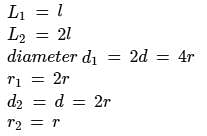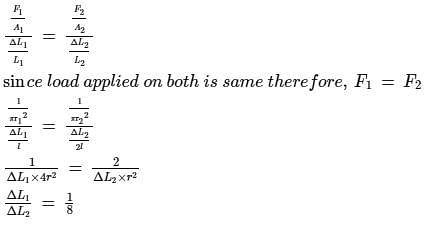Class 11 Exam > Class 11 Questions > Two wires are made of the same metal. The len...
Start Learning for Free
Two wires are made of the same metal. The length of the first wire is half that of the second and its diameter is double that of the second wire. If equal loads are applied on both wires, find the ratio of increase in their lengths?
Verified Answer
Two wires are made of the same metal. The length of the first wire is ...

since two wires are identical therefore youngs modulus of both the wire is same.

 This question is part of UPSC exam. View all Class 11 courses
This question is part of UPSC exam. View all Class 11 courses
Most Upvoted Answer
Two wires are made of the same metal. The length of the first wire is ...
Given information:
Two wires made of the same metal.
Length of the first wire is half that of the second wire.
Diameter of the first wire is double that of the second wire.
Equal loads are applied on both wires.
Understanding the problem:
We need to find the ratio of increase in the lengths of the two wires when equal loads are applied.
Solution:
Let's assume the length of the second wire as 'L' units. Therefore, the length of the first wire is 'L/2' units.
Calculating the increase in length:
We know that the increase in length of a wire is directly proportional to the load applied and inversely proportional to the cross-sectional area of the wire.
Since equal loads are applied on both wires, the increase in length of the first wire (ΔL1) is equal to the increase in length of the second wire (ΔL2).
Calculating the cross-sectional area:
The cross-sectional area of a wire is directly proportional to the square of its diameter.
Let's assume the diameter of the second wire is 'd' units. Therefore, the diameter of the first wire is '2d' units.
The cross-sectional area of the second wire (A2) is π(d/2)^2 = πd^2/4 square units.
The cross-sectional area of the first wire (A1) is π(2d/2)^2 = π(4d^2)/4 = πd^2 square units.
Calculating the ratio of increase in length:
Since the increase in length of the first wire (ΔL1) is equal to the increase in length of the second wire (ΔL2), we can write:
ΔL1/L1 = ΔL2/L2
Let's substitute the values:
ΔL1/(L/2) = ΔL2/L
Cross-multiplying the equation:
2ΔL1 = ΔL2
Therefore, the ratio of increase in their lengths is:
ΔL1 : ΔL2 = 1 : 2
Attention Class 11 Students!
To make sure you are not studying endlessly, EduRev has designed Class 11 study material, with Structured Courses, Videos, & Test Series. Plus get personalized analysis, doubt solving and improvement plans to achieve a great score in Class 11.

|
Explore Courses for Class 11 exam
|

|
Similar Class 11 Doubts
Two wires are made of the same metal. The length of the first wire is half that of the second and its diameter is double that of the second wire. If equal loads are applied on both wires, find the ratio of increase in their lengths?
Question Description
Two wires are made of the same metal. The length of the first wire is half that of the second and its diameter is double that of the second wire. If equal loads are applied on both wires, find the ratio of increase in their lengths? for Class 11 2024 is part of Class 11 preparation. The Question and answers have been prepared according to the Class 11 exam syllabus. Information about Two wires are made of the same metal. The length of the first wire is half that of the second and its diameter is double that of the second wire. If equal loads are applied on both wires, find the ratio of increase in their lengths? covers all topics & solutions for Class 11 2024 Exam. Find important definitions, questions, meanings, examples, exercises and tests below for Two wires are made of the same metal. The length of the first wire is half that of the second and its diameter is double that of the second wire. If equal loads are applied on both wires, find the ratio of increase in their lengths?.
Two wires are made of the same metal. The length of the first wire is half that of the second and its diameter is double that of the second wire. If equal loads are applied on both wires, find the ratio of increase in their lengths? for Class 11 2024 is part of Class 11 preparation. The Question and answers have been prepared according to the Class 11 exam syllabus. Information about Two wires are made of the same metal. The length of the first wire is half that of the second and its diameter is double that of the second wire. If equal loads are applied on both wires, find the ratio of increase in their lengths? covers all topics & solutions for Class 11 2024 Exam. Find important definitions, questions, meanings, examples, exercises and tests below for Two wires are made of the same metal. The length of the first wire is half that of the second and its diameter is double that of the second wire. If equal loads are applied on both wires, find the ratio of increase in their lengths?.
Solutions for Two wires are made of the same metal. The length of the first wire is half that of the second and its diameter is double that of the second wire. If equal loads are applied on both wires, find the ratio of increase in their lengths? in English & in Hindi are available as part of our courses for Class 11.
Download more important topics, notes, lectures and mock test series for Class 11 Exam by signing up for free.
Here you can find the meaning of Two wires are made of the same metal. The length of the first wire is half that of the second and its diameter is double that of the second wire. If equal loads are applied on both wires, find the ratio of increase in their lengths? defined & explained in the simplest way possible. Besides giving the explanation of
Two wires are made of the same metal. The length of the first wire is half that of the second and its diameter is double that of the second wire. If equal loads are applied on both wires, find the ratio of increase in their lengths?, a detailed solution for Two wires are made of the same metal. The length of the first wire is half that of the second and its diameter is double that of the second wire. If equal loads are applied on both wires, find the ratio of increase in their lengths? has been provided alongside types of Two wires are made of the same metal. The length of the first wire is half that of the second and its diameter is double that of the second wire. If equal loads are applied on both wires, find the ratio of increase in their lengths? theory, EduRev gives you an
ample number of questions to practice Two wires are made of the same metal. The length of the first wire is half that of the second and its diameter is double that of the second wire. If equal loads are applied on both wires, find the ratio of increase in their lengths? tests, examples and also practice Class 11 tests.

|
Explore Courses for Class 11 exam
|

|
Signup for Free!
Signup to see your scores go up within 7 days! Learn & Practice with 1000+ FREE Notes, Videos & Tests.

























